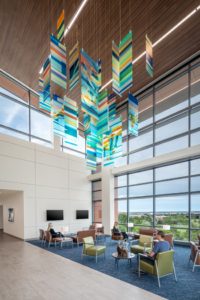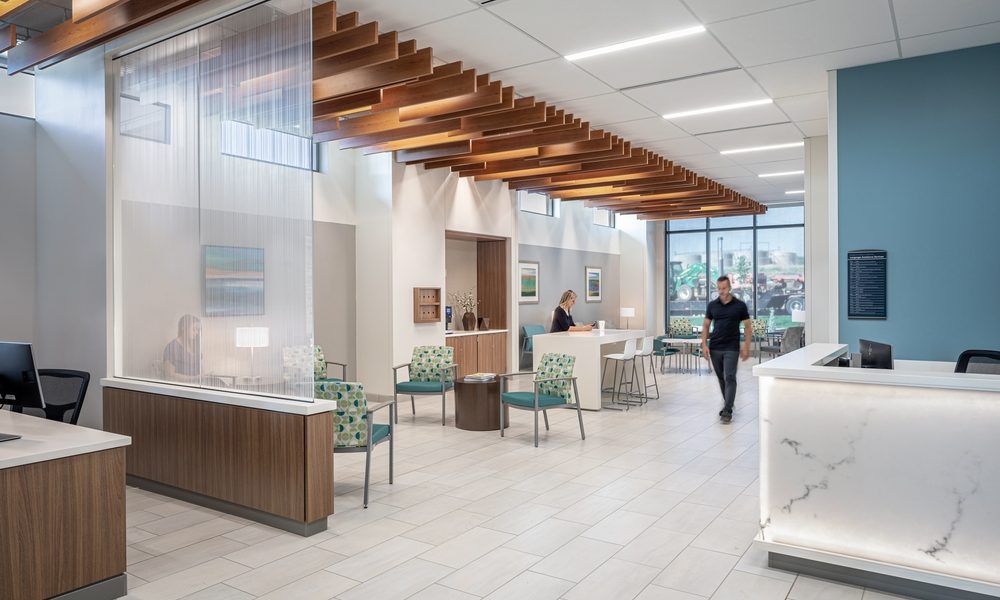 Human-centered strategies invite the ambiance of light and nature into the building.
Human-centered strategies invite the ambiance of light and nature into the building. 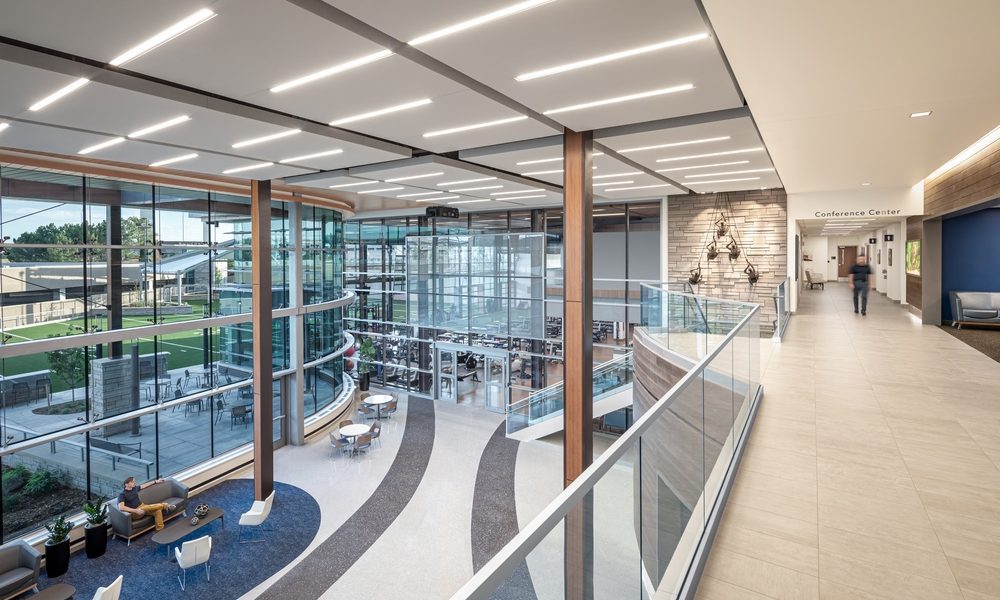 The success of human-centered design stems from the fundamental belief that design impacts healing.
The success of human-centered design stems from the fundamental belief that design impacts healing. 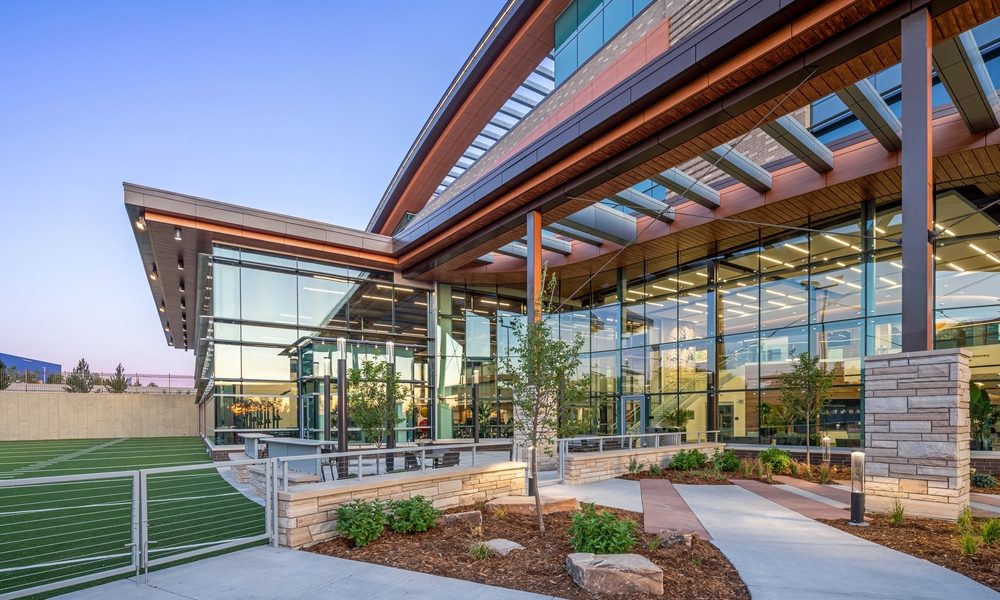 The facility at UCHealth Steadman Hawkins Clinic Denver, Colorado highlights the insertion of glass without compromising the privacy of patients inside the building.
The facility at UCHealth Steadman Hawkins Clinic Denver, Colorado highlights the insertion of glass without compromising the privacy of patients inside the building. 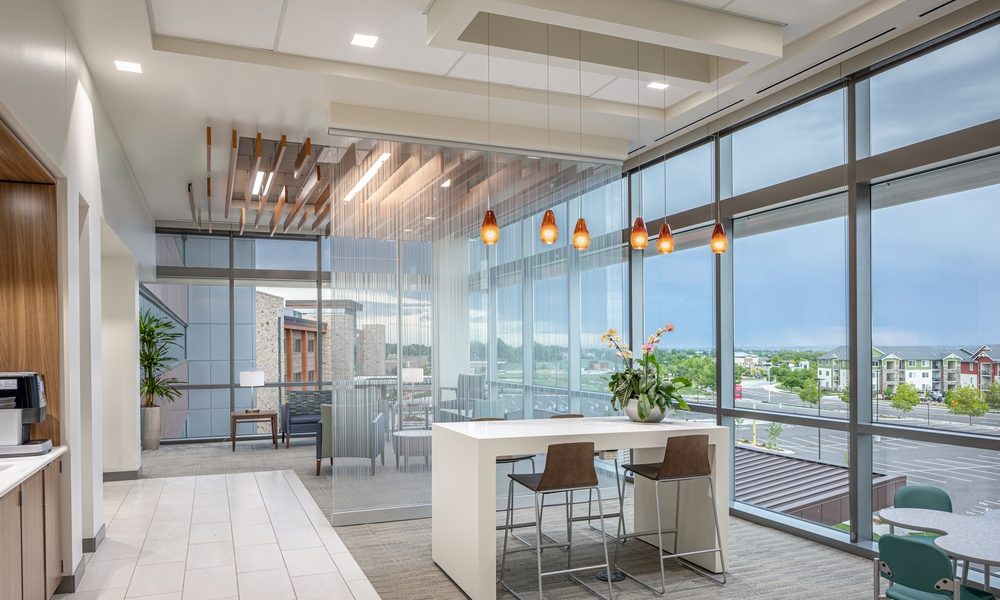 Data-driven solutions like daylight factor analysis, recorded and managed via software, can provide hard numbers, while patient studies illustrate how light and views impact healing.
Data-driven solutions like daylight factor analysis, recorded and managed via software, can provide hard numbers, while patient studies illustrate how light and views impact healing. Subscribe Now
Affordable Human-Centered Design Approach to Patient Healing + Well-Being
By Timothy J. Spence
As healthcare projects become increasingly cost-focused, human-centered design features—light, water, connection to views—are often value-engineered throughout the design process.
Yet, the value of these design elements goes well beyond dollars and cents; human-centered design features directly impact patient healing and well-being. While every project has a budget, true architecture is manifested when that budget is utilized to impact a patient’s recovery experience.
Qualitative + quantitative solutions
As leaders consider pursuing a human-centered approach while respecting budget conditions, several fundamental factors are especially helpful. The first step in a new project is to define and contextualize the challenges and to articulate the guiding principles and goals of the project. Having those goals—which are the heart and soul of the project—in place early will keep the project on track as schedules and processes increasingly intensify.
Next, research. Examine strategies with proven impact on healing and align with project objectives. Early in the project, thorough examinations of peer-reviewed journals that link research with outcomes help make the case for human-centered design.
Finally, inform and empower decision making with the results of this analysis.
Project leaders aim to use guiding principles to resolve challenges, as well as mitigate risks. This approach also involves a research-based process that employs both qualitative and quantitative solutions, representing the convergence of art and science in human-centered design.
Qualitative solutions use 3D technology and other tools to create visuals of the quality and characteristics of the space while quantitative solutions look at elements like energy, solar heat gain and the efficiency of travel through the space via computer simulation.
Once the challenges and priorities are set for the project, solutions aim to be interdisciplinary, with a collaborative, team-based approach that breaks down silos.
Shared goals developed and embraced by the whole team through early involvement of stakeholders create invaluable buy-in. Co-locating team members also maintains momentum, if feasible. Encourage collaboration, whether by co-location or periodic group sessions, that punctuate longer periods of individual work.
The following are three project types that demonstrate how healthcare leaders aim to consider strategies to create authentically human spaces for healing that are also affordable.
1. Emergency departments
Common ED Design approach. A common approach to emergency department design is a freestanding ED with a few key components.
One recent project started with a rectangular prototype building, approximately 25,000 square feet—half ED, half radiology. To emphasize human-centered design qualities within the project, the team’s initial consideration was to connect the building to the site through light, views and accessible outdoor space.
The project team proposed a courtyard, to which stakeholders expressed a concern as it would require added lifecycle cost to maintain an additional exterior envelope.
Green space + glazing. Through an iterative process, an L-shaped building form emerged, featuring green space, as well as a concentration of transparency in the internal corner of the “L.” The exterior green space aligned with the interior patient circulation from triage to the exam area of the ED, a strategic placement at the culmination of the patient’s ED experience.
Outside the triage area, a lounge with a view to the green space also serves patients awaiting test results. The calming views and courtyard access create a sense of serenity for patients—reminiscent of a religious cloister—where patients and practitioners retreat to enhance well-being.
Transparency detailing inside + out. One of the key design features was how glass was detailed to create contrast between the simple punched openings of the clinical box and the more extensive glazing where it mattered most at the connection to the exterior green space, an opportunity for patients and providers to connect with the outside world while also prioritizing efficiency to optimize cost effectiveness.
Designers worked with a contractor on a tilt-up construction approach that modified punched openings in exam rooms to diversify the space with glass. This created a different type of experience whether viewed from inside or out. People approaching the building circulate down a drive that highlights the insertion of glass without compromising the privacy of patients inside the building.
Once inside, the same space provides calming views for patients who may be emotionally vulnerable as they deal with pain and fear on the pathway from triage to examination.
Inviting ambiance into the core. Light and views were also juxtaposed with patient privacy through the use of a clerestory that allowed light into the ED. The clerestory provides a view outside for staff and patients. The addition of the clerestory allowed care providers to see the sky and experience natural light, reducing eye strain during high-concentration tasks.
These strategies invite the ambiance of light and nature deep within the building, even in the most interior, core spaces.
Integrating data-driven solutions and cost analysis. To enhance human-centered elements while optimizing cost, project leaders consider construction financials, as well as objective data on patient impact. Data-driven solutions like daylight factor analysis, recorded and managed via software, can provide hard numbers, while patient studies illustrate how light and views impact healing.
Using design plugins like Enscape and Cove.tool enhances the functionality of the revit model. Designers can simulate how sunlight will interact with the space, enabling them to avoid unforeseen glare, as well as correct situations where there is too much sunlight before negatively impacting the user experience of the space.
When cost is involved, the ability to evaluate qualitative and quantitative design elements and assign value is essential. This means collaborating with a construction manager and cost consultant, early in the project. With the benefit of experience, the CM can provide value analysis during the planning phases.
Owners can help by championing the human-centered design elements, joining architects to support design strategies and bring them to fruition.
2. New bed tower
Enhancing addition. At a community hospital in North Carolina, human-centered design is a key element in the new community hospital bed tower addition of 80 beds. When consulted about their preferences and goals for the building and campus, stakeholders indicated the difference between this new community hospital and their main academic medical center 12 miles away.
The academic medical center had understandably evolved into a maze of buildings that were added at intervals over the course of 60 years, with some spaces located deep within the building’s core that had no outside light or connection to the outdoors. Staff from the main hospital were often asking to be transferred to the community hospital because of the better physical working environment.
At the community hospital, the tower addition further enhanced the quality of the environment through integration with the existing design, comprised of a series of angles. The angles are designed to not only optimize solar orientation, but also create views to green courtyards, rather than directly across to another patient room.
In the new tower, the angular spatial design elements became opportune moments where people change direction and have the opportunity to immerse themselves in daylight and views, optimizing the tone of the space.
Enhancing the interior with regional quality. To emphasize connections to the nearby landscape, the design evokes the feeling of being in the canopy of trees that is common for this particular region of North Carolina. Thus, the tower is positioned to offer views of nature, rather than other buildings.
The north side of the building is oriented toward the landscape while the south side overlooks the interior green space of the courtyard near the cafeteria. While the views are very different, they are linked in terms of their connection to the outdoors.
Human-centered design at the forefront. Careful planning, as well as validation of these plans, is essential to achieving that undefinable feeling that a space or building is especially appealing. In discussing cost contingencies with decision makers, human-centered design was a priority worth investment.
Stakeholders were willing to make tough decisions up front about needs versus wants and navigate decisions—both right-sizing aspects of the project, as well as establishing significant contingencies—in order to keep the human-centered features at the forefront of the design.
3. Operating rooms
One of the most challenging places to incorporate the human-centered elements of light and views is in surgery departments. Before electricity, surgery was performed in rooms with the best light, but ORs have migrated deeper into the floorplate of the hospital where there is little to no access to natural light.
Today’s ORs include high-tech viewing equipment that sometimes requires minimal light, so the ability to control the amount of light in the space is increasingly important. With borrowed light, there is less risk of glare.
In one project, the sterile core consisted of a 20-foot space between two rows of ORs. To address the needs for tempered natural light, the team chose to introduce daylight into the sterile core through the use of skylights, from which they could then transfer natural light from the sterile core into the ORs via glass doors.
In addition to this strategy, a nearby public corridor runs along the perimeter of the OR area—the corridor is located on an outside wall offering exterior views. The proximity of this corridor allows surgeons the invaluable opportunity to connect with the outdoors, even if only periodically for just for a few seconds.
Ultimately, the success of human-centered design stems from the fundamental belief that design matters and, specifically for healthcare, that design impacts healing. By planning projects and equipping the team for success, as well as leveraging the tools for analysis and project delivery, leaders create places for transformational healing, all while respecting budgetary conditions.
Images courtesy of Caleb Tkach Photography.
Author: Timothy J. Spence
Timothy J. Spence, AIA, ACHA, LEED AP BD+C, is national healing market leader with BSA LifeStructures. He can be reached at tspence@bsalifestructures.com.
Tags: affordable design, Architecture, human-centered design
Posted October 15, 2019
More Articles:
- State of Industry Examined in ‘Healthcare Reset’ Report
- Cam Twohey Joins Kahler Slater as Associate Principal, Senior Project Architect in Healthcare Market
- Perkins Eastman Welcomes Michael Hess as Principal in New York Studio
- Guerin Children’s Inpatient Pediatric Unit at Cedars-Sinai Provides Interactive, Family Friendly Healing Environment
- CxA Workshop & Exam
Apr 29, 2024 – Apr 30, 2024 - EMP Seminar & Exam at CxEnergy 2024
Apr 29, 2024 – Apr 30, 2024 - CxEnergy
Apr 29, 2024 – May 2, 2024 - PHCC West 2024
Apr 29, 2024 – May 2, 2024 - Lean in Design Forum 2024
May 1, 2024 – May 2, 2024 - IFMA’s Facility Fusion Conference & Expo
May 5, 2024 – May 7, 2024 - ASHE Academy 2024
May 6, 2024 – May 10, 2024








